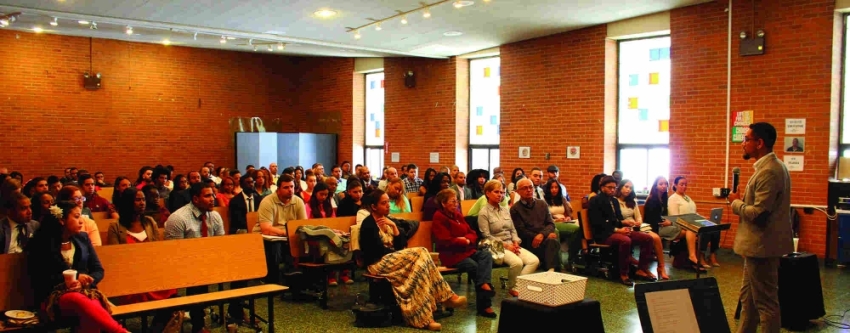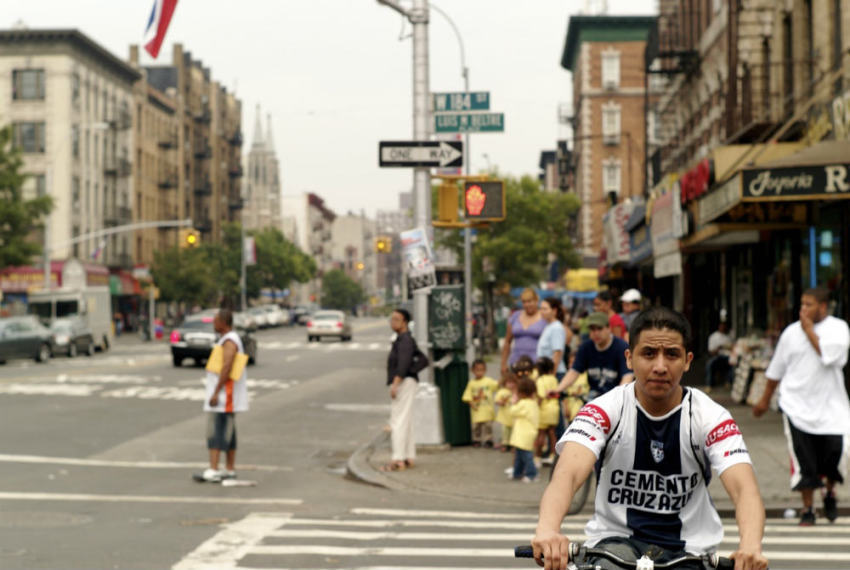Dominican-American Pastor of Youthful Church Plant Says 'God Has Really Been Doing a Thing' in NYC
Rich Perez, Pastor of Christ Crucified Fellowship, Talks Dynamics of Doing Church in Washington Heights

NEW YORK — A Dominican-American pastor leading a youthful church in a mostly-Hispanic New York City neighborhood said he is grateful to be a part of "the thing" he believes God has been doing through what he described as a surge of "sound and healthy" church plants in the Big City.
His particular part of the harvest, he believes, is in the same neighborhood where he has spent most of his life, and where he has been leading a church plant called Christ Crucified Fellowship for the past three years.
Pastor Rich Perez, 30, told The Christian Post that he felt called at the age of 19 to ministry and was particularly burdened to cultivate his community roots. Christ Crucified Fellowship in Washington Heights is situated in the northernmost part of NYC's borough of Manhattan.
Washington Heights is commonly referred to in one breath with nearby Inwood, with the joint neighborhoods sandwiched between the historically-rich Harlem to the south and the birthplace of hip-hop, the Bronx, to the north. Folks like Laurence Fishburne, Lou Gehrig, Alan Greenspan and Stan Lee have called Washington Heights home.
According to statistics referenced by the local community board, Washington Heights and Inwood are home to more than 208,000 people, with 74.3 percent of Hispanic origin, 14.1 percent White Non-Hispanic, and 8.6 percent Black Non-Hispanic. Previously populated by Irish immigrants, European Jews, and Greeks, about half of Washington Heights remains composed of immigrants, though for the last 30 years the neighborhood has been dominated by residents hailing from the Dominican Republic — like Pastor Perez's own parents.
"We are primarily of Hispanic descent so you've got second-generation Hispanic, kind of like myself. My parents were born in the Dominican Republic and we're the generation born here so we've got a whole bunch of those (in the CCF congregation). We're fluent in Spanish, comfortable in Spanish but we prefer English because we've done everything else in English (while growing up)," said Perez.
Christ Crucified Fellowship started meeting in homes as community groups in 2011, and launched Sunday services the following Easter. In addition to its primarily Hispanic makeup, CCF has seen "a large influx" of Anglos and counts an African American among its three pastors, as well as a few others among the congregation. Perez added that he also has been seeing "a whole bunch of 40-, 50-, 60-year-olds even starting to assimilate to the church" — an answer to prayers for "seasoning" among the faith community, "to kind of offset some of the youth that we have." According to Perez, CCF"s dominant age group is 25-34 years old.
The church is home to about 70 members, including Perez's parents and younger brother, with Sunday attendees usually numbering over 100. Late-afternoon Sunday meetings are held at a local Christian school, and the style is more T-shirts and sneakers than blazers and dress shoes. During The Christian Post's visit to CCF in May, Pastor Rich preached a post-Pentecost message, using a whiteboard to illustrate the work of the Holy Spirit in a maturing believer's life. His stick figures elicited a few chuckles. The youthful faces, after the service concluded, beamed enthusiastically when asked by CP what makes CCF stand out. The common response: the faith community's commitment to being warm and welcoming.
It is that same mindset Perez encourages congregants to take with them when they head out the door, and embody in general in their daily lives. According to the married father of two young children, that is how his people are called to live on a basic level, as Christians seeking good for their city.
"I think the best way to diagnose the city is by actively being a part of it," he said. "But try to engage folks, be active with knowing who your neighbors are. The everyday things that we normally tend to ignore, they could go a long way. Making a little extra conversation with the person who makes your coffee at a Starbucks, or the person who makes your coffee at the corner at the bodega. Those things go a long way and help you diagnose the spiritual climate of your environment, of your neighbors and ultimately of your city."
Perez said at another turn, in regard to his community's needs, "I grew up here. I spent 26 of my 30-year-old life here in this community. Forty-seven percent of kids grow up without a dad or grow up in a single-parent home of which most of the time it's the dad that's missing, so there's a lot of dysfunction in the family."
However, "I think that's changing a bit because we're seeing a little bit of a shift in demographics. We're starting to see a lot more younger families moving into the community."

Drug use in Washington Heights, heavily affected by the 1980s crack cocaine epidemic and notorious for being the U.S. Northeast's largest distribution center for narcotics, has been on the wane too, according to Perez.
"It still kind of lingers a bit but it's not as prevalent as it was several years ago," he told CP.
All of that in mind, Perez seems more pressed on stewarding the youth in Washington Heights to build a fruitful legacy. The neighborhood is home to Manhattan's largest concentration of kids and youth, ranging in age from 5-19 years old.
"There's a lot of legacy-building whether we like it or not," said Perez. "We either build a bad legacy or we build a good one. With that amount of youth in our neighborhood, whatever we do with them is what our community is going to look like in a couple of years."
When talk turned to the climate of New York City in general, home to more than 8 million people who are Catholics, Jews, Muslims, Christians of various denominations, Buddhists, Scientologists, atheists, and so on, Perez affirmed that his city is indeed a very religious one — to a fault.
"New York is the culture that says it's OK to search for spiritual truth, but it's not OK to say that you found it," he said. "The reason why I describe NYC that way is because everybody's spiritual, everybody's got something to say about faith or God or the divine. But the minute Christians say, 'We've found what everyone's been looking for,' which is truth, or intimacy with the divine, the minute we say that as Christians is the minute that people just accuse us of bigotry and accuse us of narrow-mindedness."
But on that front, too, he also sees changes, with God's hand in the mix.
"With the starting of several new churches, God's been really doing a thing in NYC and I'm just excited that we get to be a part of what God is doing in this decade and prayerfully in the future with His people," added Perez, whose church was launched with support of the North American Mission Board in NYC. NAMB NYC, a Southern Baptist Convention entity, displays in a busy map on its website dozens of current and potential church plants across NYC's five boroughs.
"I'm talking about a plethora of people that are starting churches that are sound, healthy, and this kind of incarnational mindset with just getting to know the dude that lives across the hall from you before you go overseas to do missions. ... I think that that mindset within churches that are getting started now is gonna be a healthy thing for New York. Still a lot to climb, but I think God is doing some things."
He hopes and prays God does some things with CCF as well, particularly in the area of growth.
"The more people we have, the more people are out being witnesses and the more people can come to Jesus. As far as it relates to numbers, one of the biggest things that we've been praying for is, 'God, where do you want us to go next? What is the next community close to us in proximity that you want us to go? What's our Samaria, what's our Judea that you want us to go to, before we begin thinking about the end of the earth?'"
The signs, so far, seem to point to Spanish Harlem, also known as East Harlem or El Barrio, where one of CCF's pastors was born and raised.
"So we've just been dialoguing on what it would be like if (he) and his family moved into Spanish Harlem and just began to build life there. And if we encouraged people to move and plant their roots down in Spanish Harlem and began as a community group, really slow. Just the same way we started this church, really slow-moving, being thoughtful, being prayerful about what we do, and starting a congregation there in the next several years," explained Perez.
However CCF's future might unfold, ultimately, he added, "We want to be known as a church community that tells the story of God and invites people into it. If we're telling the story of God the way He's told it to us and inviting people into that, then I think we've been successful. If we can cultivate people who are constantly doing that, and doing it faithfully and doing it humbly, then I think that's a real success for us."



























